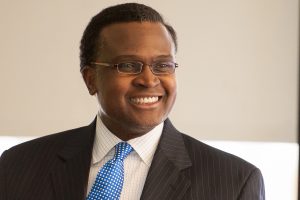For the uninitiated, rhetoric might seem a relic of ancient Greece and Rome, as set in stone as marble busts of Aristotle and Cicero. Colgate Associate Professor Kermit Campbell aims to prove otherwise. As chair of the Department of Writing and Rhetoric, Campbell advocates that rhetoric — the fine art of discourse, of speaking and writing effectively as a means of persuasion and communication — is not only alive and well but thriving beyond the classical canon.
In particular, Campbell’s work amplifies authentic voices of the African American experience that too often have been muted or ignored. He showcases these voices not only in his course “Rhetoric in Black & White: Communication and Culture in Conflict,” but also in his recent editorial contribution to the Routledge Reader of African American Rhetoric.
“In the reader as well as my course, I try to clarify where we’re each coming from as cultural and social beings, as people who are oftentimes bogged down by racial identity,” he explains. “There is clearly miscommunication between black and white citizens in our country. It’s easy for some people to think negatively of anyone who uses ‘black English,’ or African American vernacular English, and to consider them uneducated or inarticulate. I try to give people an idea of where certain expressions and uses of language come from, so they can better understand the culture and experiences behind them.”

Professor Kermit Campbell
Historical context is crucial to that understanding. In fact, the Routledge Reader’s subtitle, “The Longue Durée of Black Voices,” clearly conveys that the anthology is taking a long historical view of the evolution of African American rhetoric. “There has been this long duration of voices speaking their desire for freedom, independence, and justice,” Campbell says. “These works chronicle the black voice trying to assert itself on an equal footing with the rest of humanity.”
The chapter that Campbell curated and edited falls at a key pivot point in that evolution. Titled, “Nobody Knows Our Name: African Orature in the American Diaspora,” the chapter spans the transition from the oral traditions of Africa through the bridge of Pidgin and Creole spoken by slaves after arriving in the New World to the inventive expressions of the emerging and expanding African American culture. “The chapter covers a great deal of ground,” Campbell admits.
The challenge for Campbell lay in covering that ground in only nine entries. Well, ten if you count the chapter title, which pays homage to the James Baldwin book Nobody Knows My Name. “There is significance in being named, being regarded,” he says. “The rhetorical purpose of these pieces is to affirm one’s identity, one’s value, one’s humanity, and that should not be diminished because of the way one speaks.”
Campbell first had to address the question, “What qualifies as African American rhetoric?” The subject is hotly debated in academic circles. “There are vastly different points of view,” he says. “Some would say anything spoken or written by an African American is part of our rhetorical tradition. Those at the opposite end would consider only formal speeches, such as those of Dr. Martin Luther King Jr. I try to walk a fine line in between the two.”
His chapter reflects that deft balance, taking readers on a journey that feels at once familiar and uncharted. Works by famous authors and familiar literary devices serve as signposts along the way. For instance, the trickster god character found in many cultures stars in Eshu of the Yoruba, one of two African folktales that open the chapter. An excerpt from Alex Haley’s bestselling epic Roots serves as the inflection point from the ancestral homeland to enslavement in the New World.
Some would say anything spoken or written by an African American is part of our rhetorical tradition. Those at the opposite end would consider only formal speeches, such as those of Dr. Martin Luther King Jr.
To reflect the slave experience, Campbell selected works by two well-known authors. The poem “The Creation” by James Weldon Johnson (best known for his anthem “Lift Every Voice and Sing”) sets God’s creation of the world firmly in the South, cypress swamps and all. “Religious worship was one of the few liberties that slaves enjoyed, within bounds,” Campbell says. “It was important to include Johnson’s sermon to reflect that, as well as to show examples of the tales that slaves told to make fun of their master, which helped them survive and have some humor in their lives.” Two spirited stories by the renowned Zora Neale Hurston — “Why Negroes are Black” and “Ole Massa and John Who Wanted to Go to Heaven” — unfold in the vernacular of that time.
As the chapter veers into more contemporary times, Campbell takes some surprising and exhilarating turns off the rhetorical canon highway. Selections explore the language of “yo mama” jokes — known on the streets as “The Dozens” — as well as women’s jump-rope rhymes. “African American women express themselves quite differently than men,” Campbell says. “We need to look more purposefully at women’s contributions to what we are calling African American rhetoric.”
Another piece deconstructs the story Stackolee, which was popularized as the number 1 radio hit “Stagger Lee” in 1959 but actually is a shining example of the African American toast tradition of urban heroic narratives. The chapter closes with a tribute to the disc jockeys on black-appeal radio stations whose rapid-fire rhyming patter inspired countless rap artists who followed.
“People may have a passing familiarity with some of these things because they have made it into the popular culture through rap music, sitcoms, or black comedians,” Campbell says. “But it’s hard to fully appreciate it unless you’re familiar with the culture behind it. I hope that the chapter inspires people to want to look deeper.”
